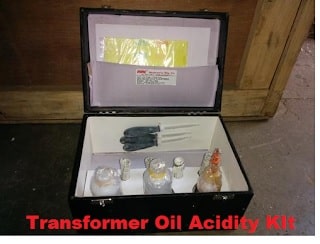- Purpose: Measures the amount of potassium hydroxide (KOH) needed to neutralize acids in transformer oil.
- Ideal Value: Healthy transformer oil has an acidity (neutralization) value of 0.3 mg KOH/g or less.
- Causes of Acidity: Oxidation due to air contact, heat, and catalysts like iron or copper.
- Effects of High Acidity: Lowers oil resistivity, increases dissipation factor, forms sludge, and damages insulation.
- Testing Method: Uses an acidity test kit with rectified spirit, sodium carbonate, and a universal indicator for visual detection.
The transformer oil is used for insulation and cooling purposes in a transformer. The acidity Test of Transformer oil is a crucial test for analyzing the oxidation of transformer oil.
The acidity test measures the acidity content in the transformer oil. The transformer oil Acidity Test is carried out using a transformer oil acidity kit.

Key Transformer Oil Parameters for Acidity
The ideal neutralization (acidity) value of transformer oil is 0.3 mg KOH per gram, indicating that the oil is healthy and free from significant oxidation. Values higher than this suggest degradation or contamination.
The table below shows the key transformer oil specifications relevant to acidity.
| Parameter | Value |
| Neutralization Value (Total Acidity) | 0.3 mg KOH/g Max |
| Resistivity at 27°C | 1500 x 10¹² Ω-cm Minimum |
| Resistivity at 90°C | 35 x 10¹² Ω-cm Minimum |
| Oxidation Stability (Neutralization after 16 hrs at 100°C) | 0.40 mg KOH/g Maximum |
| Oxidation Stability (Total Sludge after 164 hrs at 100°C) | 0.10% by weight Maximum |
| Breakdown Voltage (New Oil) | 30 kV Minimum |
| Breakdown Voltage (After Treatment) | 60 kV Minimum |
Any deviation in the above-given transformer oil parameter shows that some defect has developed in the transformer insulation system.
Causes of Acidity in Transformer Oil
Sometimes the transformer oil comes into contact with air. This condition happens when there is a leakage of oil from the transformer tank or pipeline. The transformer oil oxidizes when it comes into contact with air.
The oxidation process further accelerates because of high temperature and the catalysts like iron and copper and metallic compounds mixed in the transformer oil.
Effects of Acidity in Transformer Oil
The resistivity of the transformer oil is 35 x 1012 Ohm-cm and 1500 x 1012 Ohm-cm at 90°C and 27°C respectively.
The resistivity of the transformer oil decreases with increased oxidation—the decreased resistivity of the transformer oil with an increased acidity causes paper destruction.
Increased acidity also increases the dissipation factor (tanδ) of the transformer. The rate of sludge formation also increases with increased acidity of the transformer oil.
How to Measure Acidity in Transformer Oil
When the acidic material is to be neutralized, the alkali material is added to it. The neutralization of the effect can be examined by the amount of base material added to the acidic material.
The same principle is used to calculate the acidity of the transformer oil. The substance required to measure the acidity of transformer oil is potassium hydroxide. It is also commonly referred to as caustic potash.
The potassium hydroxide (KOH) is added to the transformer oil sample in a specific quantity to neutralize the acidity effect of the transformer oil.
The acidity of the healthy transformer oil is 0.3 mg KOH/gram. It means 0.3 milligrams of KOH is required to neutralize 1 gram of insulating oil.
Principle of Transformer Oil Acidity Test
The neutral solution has a PH value of 7. The acidic material has a PH value of less than 7, and the alkali material has a PH value above 7.
The acidity of the standard oil is 0.3 mg KOH/gram. When alkali material is added to the transformer oil, it may remain acidic if the alkali is added to neutralize the acidity effect of the transformer oil.
The transformer oil may attain a neutral state with a PH value of 7 if the 0.3-gram alkali is added to the 1-gram transformer oil. If the alkali added to the transformer oil is more than 0.3 mg in 1 gram, the oil may attain a PH value of more than 7, and the oil becomes alkaline.
The transformer oil’s pH value must be below 7. It must also have acidic properties. The acidic nature of the transformer oil can be visualized by observing the color of the strips when they are dipped in it.
By determining the neutralization value, you can assess transformer oil quality and detect early signs of oxidation or degradation.
Procedure of Transformer Oil Acidity Test
- One gram of transformer oil is taken to test its acidity. A volumetric syringe takes one milliliter of transformer oil.
- The acid present in the transformer oil is highly dissoluble in the alcohol. So, the dissolved acid in the transformer oil is extracted by adding 1 ml of rectified spirit(ethyl alcohol).
- After shaking the test sample, 1 ml of sodium carbonate is added.
- Then, we add five drops of universal indicator to the sample.
- After adding the universal indicator, the solution changes its color, and the color chart will show how much acid is contained in the insulating oil.

Conclusion
Regular acidity testing of transformer oil is essential for maintaining insulation quality and preventing transformer failures.
By monitoring the neutralization value and keeping it within the ideal limit of 0.3 mg KOH/g, technicians can detect early oxidation, reduce sludge formation, and extend transformer service life.
Implementing timely corrective actions—such as oil filtration or replacement—ensures reliable transformer performance and minimizes costly downtime.
Related Articles:
1 thought on “Acidity Test of Transformer Insulating Oil”